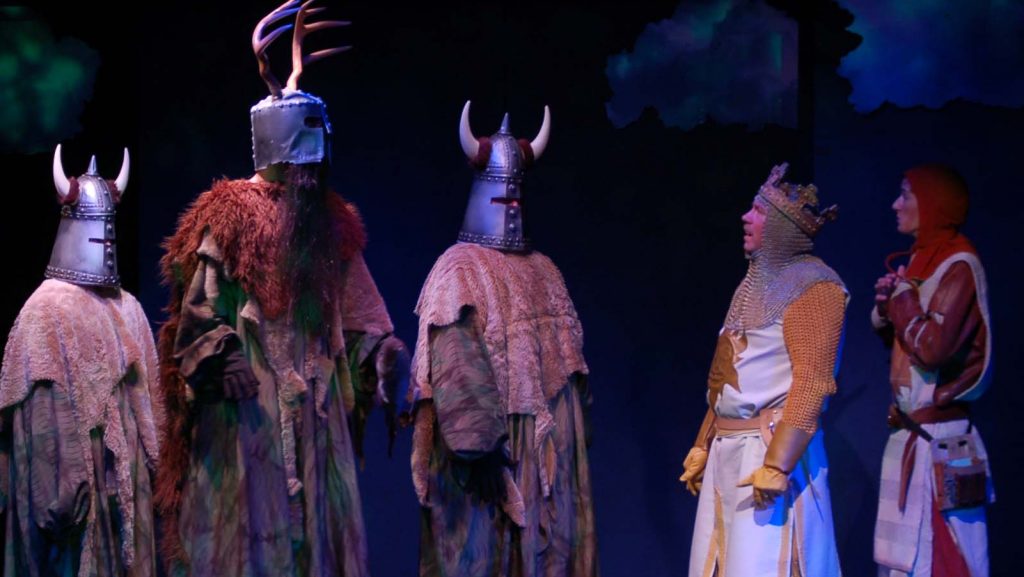Getting in the driver’s seat for a production of MONTY PYTHON’S SPAMALOT, the Eric Idle and John Du Prez penned Tony Award®-winning Best Musical, is a true opportunity to give your cast, crew and audiences the theatre experience of a lifetime. Since launching the wide-release of SPAMALOT over a year ago, there have been hundreds of productions around the world by groups from community, high school and university theatres to high profile professional companies to a new West End production, still lighting up the stage in London. SPAMALOT is a ticket sales machine wherever it is produced for the sheer excellence of a show that has become a beloved musical classic, that never existed in the shadow of its wonderful and iconic cinema source material Monty Python and the Holy Grail.
 Representing SPAMALOT is a labor of true love and hearing from our customers about what a joy this show is to present is a daily thing. We also get lots of great questions about the show from folks who are ready to take the Python-plunge but need a nudge, nudge to send the money and put it on their season. While this brilliant show is built on the Python classics (yes your audiences WILL say the lines of SOME parts with the actors), SPAMALOT takes it’s movie mommy to a new place as a true classic of the American Musical Theatre. While lovingly skewering Big Broadway, it takes the form on like a seasoned pro, expertly crafting a defining book musical with a big heart, wrapped in an irresistibly silly escape. OK…love the show. Got it.
Representing SPAMALOT is a labor of true love and hearing from our customers about what a joy this show is to present is a daily thing. We also get lots of great questions about the show from folks who are ready to take the Python-plunge but need a nudge, nudge to send the money and put it on their season. While this brilliant show is built on the Python classics (yes your audiences WILL say the lines of SOME parts with the actors), SPAMALOT takes it’s movie mommy to a new place as a true classic of the American Musical Theatre. While lovingly skewering Big Broadway, it takes the form on like a seasoned pro, expertly crafting a defining book musical with a big heart, wrapped in an irresistibly silly escape. OK…love the show. Got it.
Over the last year we received hundreds of great photos and emails from directors around the world about their SPAMALOTs and I reached out to three of them to ask if they would share some time to discuss the finer points of mounting the show. Actor’s Cabaret of Eugene (ACE) Director Joe Zingo was unable to make the date so he joined us via technology. He directed his smashing SPAMALOT at ACE in Oregon in summer of 2012 in one of the first productions post-release, marking the Northwest US Premiere. The other two readily agreed, so we flew them in to NYC and put ’em up at the Four Seasons and dined at…at…Sardi’s, yeah…while doing the interview accompanied by several glasses (bottles) of pricey sparkling water.**
Our dinner-view guests are Mark A. Zimmerman, the Director of Ohio’s Akron School for the Arts, who directed SPAMALOT in March of 2013 and Otto Layman, Director of the Santa Barbara, CA High School Theatre, who delivered his Grail in April of 2013.

Fred Stuart: Thanks for coming guys. I trust everything at the Four Seasons is cool?
Mark Zimmerman and Otto Layman: Yes. It is nice.
FS: So let’s dive right in. Mark. What other shows have you done in the past few years and what led you to select MONTY PYTHON’S SPAMALOT in 2013?
MZ: We have spent the past ten years or so pursuing musicals that are either brand new or unusual for a high school.
FS: Nice! And…lean into the mic when you talk just a little there. Not that much. Good. What other new-ish shows recently?
MZ: We have presented shows such as THE PRODUCERS, THE COLOR PURPLE, HAIRSPRAY and LEGALLY BLONDE at the first possible moment.
FS: Hmmmm. Love THE COLOR PURPLE, those others aren’t familiar…
MZ: As a performing arts school we want to challenge our students with material that they are unlikely to have seen elsewhere and also to blaze a trail for other area schools when it comes to play selection. I have a short list of shows I am prepared to present as soon as they become available. Spamalot has been one of those. I tried to pry it away from you in 2012 for an All-City Musical production but was gently denied.

FS: Just doing our job, Mark. The tour was still out.
MZ: A student mentioned to me over the summer that it was available and I applied for the rights before the end of the day.
FS: Smart kid! Probably heard about it on the Facebook. Otto, were your audiences and cast inviting of a newer-style Broadway show?
OL: Very much so! In a small city that has three public high schools, and a few smaller private high schools, four or five small professional groups and PCPA to the north, there is a fierce competition for titles and for the general public audience—and I am happy that we are given the opportunity to work on shows that are contemporary—usually the trickle down to high school from Broadway is 8 to 10 years. Having titles that have played recently is great for recruiting—especially if we get them before other schools! While the scope and professionalism of what we do is a great recruiting tool, so is our ability to show modern students that we are able to produce modern works. Audiences have grown as word of mouth has grown our reputation, and being able to give Santa Barbara and its big tourist trade a quality production that competes nicely with local professional theatres.
FS: Mark, your production was very well received too, yes?
MZ: The response I received from the community was overwhelmingly positive…They have mostly told us that we “nailed” it.
OL: Spamalot is a show that allows for, that encourages, demands and insists upon the creative input of the actor. I love actors, and trust them to bring their own sensibility to the play. Spamalot was probably the greatest rehearsal period we’ve ever had, and most rehearsals were funnier than the show, I think, as we had to decide what to keep and where to move on. It’s a great show for getting young actors outside of themselves and letting go as performers-because the fear of looking silly is antithetical to the spirit of Python.
FS: Was there anything that stands-out to you as far as your students ‘connecting’ with the style of the show?
OL: Spamalot is a show that allows for, that encourages, demands and insists upon the creative input of the actor. I love actors, and trust them to bring their own sensibility to the play. Spamalot was probably the greatest rehearsal period we’ve ever had, and most rehearsals were funnier than the show, I think, as we had to decide what to keep and where to move on. It’s a great show for getting young actors outside of themselves and letting go as performers-because the fear of looking silly is antithetical to the spirit of Python.
FS: Did you find your young actors were familiar with Monty Python?
MZ: Many of my students were familiar with Monty Python and were excited about the show. I know that at least a few students auditioned for the show simply because they were Python fans. In particular, the young man who played the French Taunter and the Swamp Castle Guard was especially excited to audition for his first musical as a senior and likely would not have done so for another show. His taunting was definitely one of the highlights of the show.
FS: Your mother was hamster!
MZ: My son in particular has been a Python fan since a young age and became the go to guy for how a costume or prop should look to best reflect the film. He and I had both seen the Broadway production so we had a good idea for how the show should be and we ran with it. He was originally assigned to the show as a student production manager but ended up being a lighting co-designer (with me) and also playing the role of Tim the Enchanter. His work on all three areas was excellent and I am very proud of him.

FS: As well you should be. Otto, any particular casting innovations, use of girls in non-traditional casting stuff? Some folks worry there aren’t girl roles in this thing.
OL: Our very gender-flex casting seemed to really work! Not really a challenge at all. Except for the principal knights everything else is readily adaptable and gender-flexible. I think our cast list was pretty much 50/50, and the suggestions in the material from TRW was extremely helpful.
FS: You’re welcome.
OL: Girls as well as boys were able to connect with the show in a meaningful and powerful way. One thing about Spamalot I found was that there is an emotional core that is authentic, and the love of the Knights for each other played against the buffoonery of the plot makes for a very rich experience.
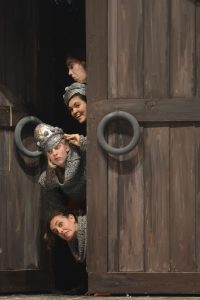
MZ: We had to get in front of the curve on this one. As many of my students were already familiar with the show from having seen the recent tour, there was concern that there was really only one female role available and the rest were basically chorus roles. I assured everyone that we would do everything we could to feature women in other roles and I guess they trusted me because we had plenty of women audition for the show. We of course felt obligated to cast females in traditionally male roles. We cast the following roles with women without changing a single line or action: Not Dead Fred, some of the dead, the Monks, the Knights Who Say Ni, Concorde, Mrs. Galahad, who is traditionally played by a male, and two of the minstrels.
FS: Galahad’s mom should be a boy! IMHO, bro. It’s cool.
MZ: Interestingly enough, once we got into rehearsal it became apparent that we were short one Laker Girl because we could not spell out the name Galahad even with Mrs. Galahad being assigned the final “D.”
FS: That part is always fun in rehearsal. And by fun I mean, get your ducks in a row before you stage it!
MZ: Yeah, we wrestled with that a little bit and eventually cross-cast that role with a male actor who volunteered to fill the role. He also played the parts of Herbert and the Finnish Mayor. I was glad to add him as a Laker Girl to further feature him in the show and as a nod to the Python tradition of cross-casting.
FS: Well done, sir. Clink. So, what did audiences think?
MZ: It is interesting how different audiences react differently. Our more adult audiences laughed heartily at the traditional Python set pieces. They sometimes started to laugh when a new scene began in anticipation of what was to come. As we explained to our cast, almost everyone over the age of 30 in the audience would know many of these scenes word-for-word.
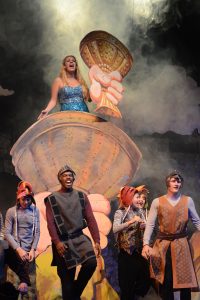
FS: Any particular set innovations, like your genius forced perspective thing with the giant Grail?
MZ: My favorite part of our set was the false proscenium we built to accommodate the tower windows in the opening scene. The entire show was viewed through what was a tremendously large castle gate and each side had a window closed with a wooden shutter. Each window was about 14 feet high and created a wonderful visual. We used it several times during the show to great effect. I would like to take credit for the forced perspective on the grail but it was really a happy accident. We cut the piece out of two-inch Styrofoam board and had the art department paint it to match the poster. When our Lady used it the first time in rehearsal we knew we had a winner. It looked fantastic. Since it was made out of foam, it was not hard or especially heavy for her to carry during the entire number.
FS: You’ve got a pretty big theater. The current West End production really takes it back to just a bare-bones production values thing and it is awesome, too. Our buddies at Actor’s Cabaret of Eugene, the director there Joe Zingo, told me he it really worked in his 75 seat theater, and I believe it! He’s a master of getting big shows in a small space and making them more than just work, they are brilliant. Since Joe couldn’t fly in from Oregon to join us here at our fancy dinner at Sardi’s, let’s text him now for a quote.
FS txt: BFF #joezingo what RU you up2? Hey. What did U do for yr set for Spamalt? TXT back NOW:)

FS: He’ll text right back. So. How’s the salmon? OOh. Here he is:
JZ txt: Cant talk rhrsal for once on this island
FS txt: never heard of that 1. you always with the new stuff:)
FS: Isn’t this aioli out of this-Ooh. Here he is:
JZ txt: shut up
FS: Oh, Joe! Ooh. He’s typing again…
JZ txt: We simplified the set into one moving castle section, which traveled the stage to accommodate the scenic needs. Plus two smaller castle sections on each of the downstage sides of the stage. don’t text me anymore plese
FS: He loves me. I gotta run to the little girls room. Talk for a long time about the set. This thing’s still recording.
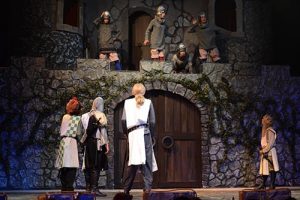
MZ: We tried to keep the scenery simple. We built a large piece that we called a “bridge” that served as the main background for the play but also as the French Castle. It turned around to reveal Swamp Castle with an added piece behind it to provide the tower winder and escape platform. The Camelot Castle split in two sections so that it could more easily be stored with the wings. Other pieces were made small enough that they could be run through a standard-sized door and into the adjacent hallway when they were not in use. We built God’s feet, His hand, and the roulette wheel out of Styrofoam sheets so that they would be light and easy to fly. The good news with special effects is that they don’t need to look all that good to work in the show. Since the whole thing is so silly, silly props and effects work just great.
WAITER: What about the Black Knight thing? Is that like impossible to stage?
MZ: The black knight sequence is perhaps the toughest trick in the show and we accomplished it thanks mostly to a diligent costume crew. Could I get a little more water, please? The audience seemed to enjoy it and accept it for what it is — a silly joke. We created a duplicate costume and stuffed it with batting. It was easily attached to the door with a hook and a built in clothes hanger. The Black Knight’s head came through a special trap door. He was able to pull a string through the door to detach the legs and allow them to fall to the floor. The funniest part is that they never did fall in unison: it was always first one and then the other. It never failed to get a big laugh.
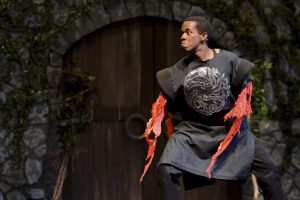
DINER AT NEARBY TABLE: What about when Lancelot’s little Patsy-like guy gets the arrow?
MZ: Our student engineering program created a tension-release device for the arrow/message Concorde receives in Act II. It worked amazingly well and was ultimately very simple.
FS: And…back! Don’t bother other tables, Mark. This is Sardi’s. There’s Matthew Broderick. What about the all-important Killer Rabbit?
MZ: I bought a rabbit online.
FS: Gotta love the Internet. In my day we had to MAKE our own killer rab-
MZ: -I suspect it was a souvenir puppet sold originally in the lobby at the Schubert.
FS: Puppets onstage for a whole musical would never work, but one for the rabbit is a killer idea.
MZ: It worked fine although I wish it had been a little bigger. Losing Bors’ head is also a challenge. We made it work and while it looked very silly it definitely got a big laugh.
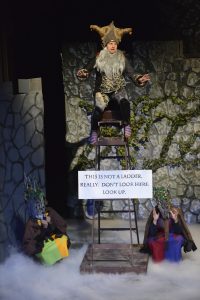
FS: Bors is like that Star Trek guy from the original, when they like landed on some planet and all the regular Kirk, Spock, McCoy, Sulu, Scotty, Chekov’s and such are there and then one guy you’ve never seen before and inside of a minute he’s killed by some weird thing. Speaking of which, there’s some combat in the Spamster. How’d you approach kids and sticks?
MZ: We struggled with the swords, not wanting to use actual stage weapons. I had initially intended to purchase wooden but we began practicing with the padded swords my son’s troupe uses in their Belagarth competitions. We eventually committed to using them in performance. In the final analysis they worked fine as they were not the focus of any scene in particular and allowed the actors to use them without concern for injuring their partner. We gave Arthur a large, elaborate toy sword to use as Excalibur.
FS: Hilarious! How now the flying cow?
MZ: Making the cow was fun! We had an art teacher work with one of his classes to “sculpt” it out of chicken wire and carpet padding. It was painted with black and white spray paint and looked fantastic. Once we put the safety railing on the bridge we knew we could no longer catapult the cow over. Instead we compromised: the two French Guards simply tossed the cow off the bridge and onto poor Patsy. It worked fine but I still wish we could have tossed her over the bridge instead of off of it.
FS: No worries. Have some more bread. What about the fish for Schlapping? When I did the show I used some I found online that were the consistency of large gummy fish. Made a nice ‘schlapping’ sound and no one got hurt. Pretty much. I cut cardboard for another production and that worked ok. We had the tech booth operate live schlapping samples from a small MIDI keyboard.
MZ: Making the fish for “Finland” was a challenge. We eventually cut fish-shaped patterns out of camping tarps, stuffed them with remnants from the cow, and had art classes paint them.
FS: Sounds labor intensive. I’d just get enormous Swedish fish. Edible prop. What’dja do with your fabulous set when it was all over?
MZ: Most of our specialty items for this show have already been claimed by a local community theatre that will present the show on their stage in the summer of 2014.

FS: Sharing is good. Speaks highly of your program that they’re using your stuff! As the process went along, did you discuss any themes arising from the content of the show with your cast?
MZ: We mostly approached the subject matter from the direction of comedy. We would often discuss why a certain event or scene was funny. I would highlight the comic elements of it for the unenlightened and would discuss the show in that context. I know we initially had trouble making “I’m Not Dead Yet” funny because the dead chorus had been staged to dance like zombies with at least one or two nods to “Thriller.” Once we realized that zombies for the most part are not funny, we could get on with the making the incongruity of a dancing/singing chorus of dead people who were decidedly not zombies.
FS: Actually, Zombies are hilarious. Have you seen The Walking Dead?
MZ: And, we gave much thought to the casting of Herbert.
FS: Yeah, I want to talk about that. “But Father, I want to SING!”
MZ: While the part is played for laughs I think it also has to come from a place of respect. I did not want to cast someone who was going to make a mockery of it. I approached one of my best performers who also happens to possess an amazingly broad singing range. He did a fantastic job and recently posted in our FB group that the show has inspired him to “find his own grail.”
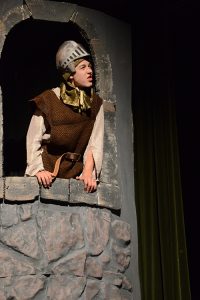
FS: Exactly! Love that! Well said, Mark. He’s kind of the heart of the show. Otto, the beautiful pictures of your show speak for themselves as far as production values. A beautiful execution of all the tech elements and a superb cast and musicians. Are there any titles fresh from Broadway you are interested in taking on next? Just fishing for a quote, here, Otto.
OL: Funny you should say “fish.” My daughter, who is a sixteen year old sophomore here at SBHS, was in New York in November and was adamant that we do Big Fish—which we will be doing as one of the first post-Broadway productions in November of 2014. So thanks for that! It is our kind of show—my choreographer is not only brilliant as a dance teacher, but she is a professional puppeteer and aerialist, so we are excited about the design possibilities. My wife and I get to LA a lot, and try to get to New York once a year—there are a couple of shows, Peter and the Starcatcher, or Natasha, Pierre and the Great Comet of 1812 were brilliant.

FS: Never heard of them. Lovely. Well, it’s time to run to catch the train. Thanks for the convo!
MZ & OL: Sure. Thanks for everything.**
FS: Thank YOU, two. And Joe! Seriously. You delivered great shows and I appreciate you sharing your SPAMALOT experiences with us…here at this fancy NYC restaurant.
**SILLINESS NOTE: This interview was actually conducted via email. Not from Sardi’s. Nobody got to fly to NYC or stay at the Four Seasons. Sardi’s doesn’t have wireless or TVs. And who the heck are all these people on the wall?
**SERIOUS NOTE: I had the real pleasure of meeting Mark A. Zimmerman at the 2013 EDTA Thespian Festival in June of 2013, and his knowledge and excitement about SPAMALOT was remarkable. He runs a superb Theatre program at Akron School for the Arts, in Akron, Ohio. My thanks to him for sharing his expertise. Otto Layman was kind enough to share his photos of his SPAMALOT and after seeing them we had to talk! His program at Santa Barbara HS is a model of excellence. Joe Zingo is Director of the venerable Actor’s Cabaret of Eugene, Oregon and a longtime friend of Theatrical Rights Worldwide. My thanks to all three of them.
